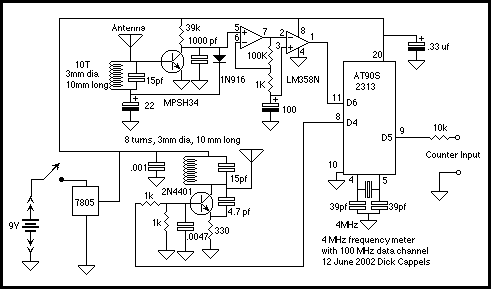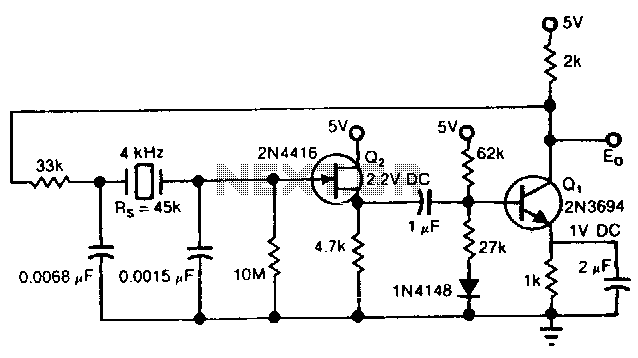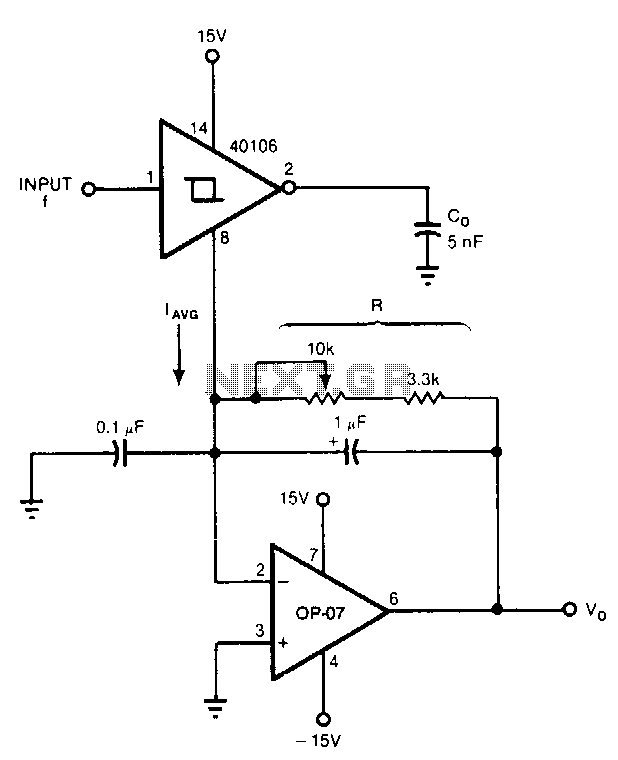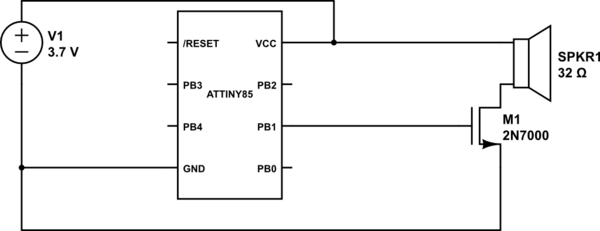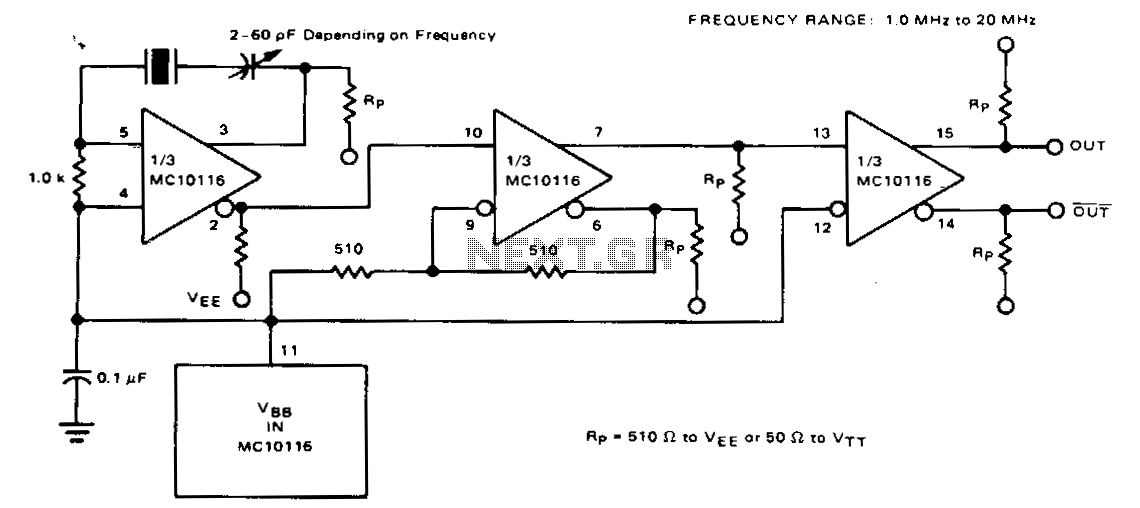
cheap frequency counter
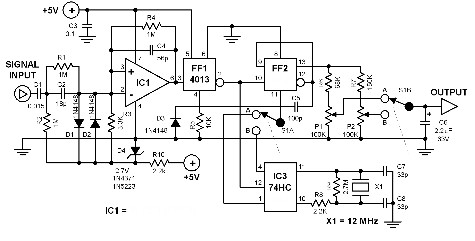
This frequency counter utilizes an existing digital multimeter (DMM) as the display unit, allowing for a low-cost construction. Due to the high impedance characteristic of most DMMs, a frequency-to-voltage converter can be easily connected without matching issues. The converter illustrated in the diagram operates within a frequency range of 10 Hz to 1 kHz (position A) and 1 kHz to 100 kHz (position B). The sensitivity at lower frequencies, from 10 Hz to 1 kHz, is approximately 35 mVpp, which increases to 350 mVpp at a frequency of 100 kHz. The DVM must be connected to the positive and negative terminals of the converter's output. The conversion in range A is 1 kHz = 1 V, and in range B, it is 100 kHz = 1 V.
The described frequency counter circuit is designed to provide a cost-effective solution for frequency measurement by leveraging the capabilities of a digital multimeter. The core component of the circuit is the frequency-to-voltage converter, which translates frequency signals into corresponding voltage levels that can be easily read by the DMM.
In position A, the converter is configured to measure frequencies from 10 Hz to 1 kHz. The output sensitivity of 35 mVpp allows for accurate readings at lower frequencies, ensuring that even small signal variations can be detected. The DMM is connected to the output terminals of the converter, where it interprets the voltage levels as frequency values. The linear relationship established in this range means that a frequency of 1 kHz will yield an output voltage of 1 V, facilitating straightforward calculations and readings.
In position B, the frequency range extends from 1 kHz to 100 kHz, where the sensitivity increases to 350 mVpp. This increase in sensitivity at higher frequencies ensures that the DMM can accurately measure rapid changes in frequency. The conversion ratio remains consistent, with 100 kHz corresponding to an output of 1 V, allowing users to switch seamlessly between frequency ranges without recalibration.
The design emphasizes ease of use and integration, as the high input impedance of the DMM minimizes loading effects on the circuit. This characteristic is crucial for maintaining the integrity of the frequency signal being measured. Overall, this frequency counter circuit represents an efficient and economical approach to frequency measurement, suitable for various applications where precision and cost-effectiveness are paramount.This frequency counter uses your existing digital multimeter as the display unit that is why it can be constructed at very low cost. Due to the high impedance of most DMMs, a frequency to voltage converter can be easily connected to it without matching problems.
The converter shown in the diagram has a frequency range of 10 Hz up to 1 kHz (positio n A) and 1 kHz up to 100 kHz (position B). The sensitivity at low frequencies 10 Hz up to 1 kHz is around 35 mVpp and increases to 350 mVpp at a frequency of 100 kHz. The DVM you are going to use must be connected to the plus and minus terminals of the converter`s output.
The conversion in A range is 1 kHz= 1V and in B range is 100 kHz= 1V. 🔗 External reference
The described frequency counter circuit is designed to provide a cost-effective solution for frequency measurement by leveraging the capabilities of a digital multimeter. The core component of the circuit is the frequency-to-voltage converter, which translates frequency signals into corresponding voltage levels that can be easily read by the DMM.
In position A, the converter is configured to measure frequencies from 10 Hz to 1 kHz. The output sensitivity of 35 mVpp allows for accurate readings at lower frequencies, ensuring that even small signal variations can be detected. The DMM is connected to the output terminals of the converter, where it interprets the voltage levels as frequency values. The linear relationship established in this range means that a frequency of 1 kHz will yield an output voltage of 1 V, facilitating straightforward calculations and readings.
In position B, the frequency range extends from 1 kHz to 100 kHz, where the sensitivity increases to 350 mVpp. This increase in sensitivity at higher frequencies ensures that the DMM can accurately measure rapid changes in frequency. The conversion ratio remains consistent, with 100 kHz corresponding to an output of 1 V, allowing users to switch seamlessly between frequency ranges without recalibration.
The design emphasizes ease of use and integration, as the high input impedance of the DMM minimizes loading effects on the circuit. This characteristic is crucial for maintaining the integrity of the frequency signal being measured. Overall, this frequency counter circuit represents an efficient and economical approach to frequency measurement, suitable for various applications where precision and cost-effectiveness are paramount.This frequency counter uses your existing digital multimeter as the display unit that is why it can be constructed at very low cost. Due to the high impedance of most DMMs, a frequency to voltage converter can be easily connected to it without matching problems.
The converter shown in the diagram has a frequency range of 10 Hz up to 1 kHz (positio n A) and 1 kHz up to 100 kHz (position B). The sensitivity at low frequencies 10 Hz up to 1 kHz is around 35 mVpp and increases to 350 mVpp at a frequency of 100 kHz. The DVM you are going to use must be connected to the plus and minus terminals of the converter`s output.
The conversion in A range is 1 kHz= 1V and in B range is 100 kHz= 1V. 🔗 External reference
